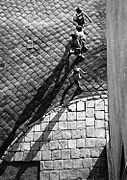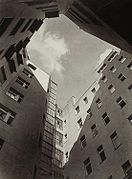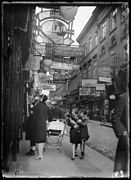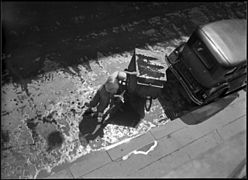Imre Kinszki
Imre Kinszki (born March 10, 1901 in Budapest , Hungary , † 1945 probably in Sachsenhausen concentration camp ) was a Hungarian photographer .
Life until 1943

Imre Kinszki grew up in an assimilated Jewish family of intellectuals in Budapest. His grandfather, Zsigmond Schiller, was editor-in-chief of Pester Lloyd , the leading German-language daily newspaper in Hungary at the time. Lipot tree Horn , one of the most famous Hungarian synagogues - architects , was his uncle.
After graduating from the Piarist High School in Budapest, Kinszki began studying medicine at the Medical University , but had to give it up after just one semester due to the anti-Jewish laws passed in 1920 . He then went on to study biology at the University of Sciences and Humanities for another semester . The attempt to continue his medical studies failed in 1921 because of a numerus clausus , which had been passed in the meantime , which severely restricted the access of Jews to universities. Kinszki spoke five languages and during that time published articles on philosophy and politics .
After breaking off his university career, Kinszki took a job as an archivist at the Hungarian Union of Manufacturers . There he met Ilona Gárdonyi, whom he married in 1925. A year later their son Gábor was born, followed by daughter Judit in 1934.
After his wife had given him his first camera in 1926 , Kinszki turned to photography , which he now pursued alongside his office job as an ambitious amateur photographer. A special interest was the macro photography ; In 1931 he even developed a special 6 × 6 camera for this purpose : the “Kinsecta”. In 1931 he joined the Hungarian Association of Amateur Photographers (MAOSZ). Since then, his photographs - but also articles on the technique of photography - have been published regularly in both Hungarian and international specialist magazines, including National Geographic , Popular Photography and American Photography . In the 1930s he took part in numerous international photo exhibitions and also appeared as an organizer of exhibitions. In 1937 he was co-founder of the Association of modern Hungarian photographers , in 1939 he was co-editor of the publication “Ungarische Fotografie”. He was in contact with internationally renowned photographers such as László Moholy-Nagy , Brassaï and Albert Renger-Patzsch .
Kinszki propagated a modern direction in artistic photography and is today considered to be one of the most consistent representatives of the New Objectivity in Hungarian photography. He developed techniques for the representation of movement and night scenes and experimented with extreme perspectives (such as steep views ), with the effect of light and shadow in the early morning hours and hard contrasts (see work examples).
Forced Labor and Death
In order to protect themselves from anti-Semitic attacks, the family Kinszki was in 1938 Orthodox Greek faith converted . Nevertheless, Imre Kinszki was interned for forced labor from 1943 , first in Romania and later in Budapest. On February 16, 1943, photographs and texts by Kinszki appeared for the last time in the journal “Képes Vasárnap”; Kinszki's last sign of life is a postcard he received in 1944 from a train station in the IX. Budapest district sent. In the spring of 1945 he was seen on the death march to Sachsenhausen concentration camp , which he presumably did not survive. In memory of Imre Kinszki and his son Gábor, who died in the Buchenwald concentration camp in the winter of 1944, two stumbling blocks were laid in front of their last apartment at 121 Róna Street in Budapest . Today there is a memorial plaque on the wall of the house.
Exhibitions during his lifetime
In addition to the exhibitions mentioned here, in which Kinszki participated during his lifetime, several internationally important art museums now have works by Kinszki in their public collections, including the Museum of Modern Art , New York , the Museum of Fine Arts, Boston , and the Stedelijk Museum in Amsterdam and the San Francisco Museum of Modern Art .
- 1931 - International Exhibition, Budapest
- 1932 - International Exhibition, Vienna
- 1933 - International Salon of Photography , Chicago
- 1936 - II. International Exhibition, Košice
- 1938 - Royal Photographic Society , London
- 1939 - Photographic Society of America , Hungarian Collection, USA
- 1939 - Exposition Internationale des Photos de Neige, Paris
- 1939 - International Exhibition, Antwerp
Work examples
For some of the works shown here, the year of creation is unknown.
Individual evidence
(Sources see literature and web links)
- ↑ a b c d KunstBüroBerlin 2016
- ↑ a b c d e FSZEK 2016
- ↑ a b c MoMA 2016
- ↑ a b c d Serotta, Dóra 2009
- ^ Nádas 2005
literature
- Péter Nádas : Soul mate / Kindred Spirits . Hungarian Photographers 1914–2003. 1st edition. Nicolaische Verlagsbuchhandlung, 2005, ISBN 3-89479-265-5 , p. 76 .
Web links
- Edward Serotta, Sárdi Dóra: Kinszki Imre 1901–1945. (PDF) Fotográfiák / Photographs. Centropa (Vienna), Vintage Galéria (Budapest), 2009, accessed on June 18, 2016 (Hungarian, also in English).
- Biography at KunstBüroBerlin (accessed June 20, 2016)
- Biography at exil-archiv (accessed June 14, 2016)
- Biography and self-portrait at the Museum of Modern Art (accessed June 14, 2016)
- Biography and examples of works at the Howard Greenberg Gallery (accessed June 15, 2016)
- Biography, work examples and portrait of Kinszki at the Metropolitan Ervin Szabó Library (FSZEK) (Hungarian, accessed on June 14, 2016)
| personal data | |
|---|---|
| SURNAME | Kinszki, Imre |
| BRIEF DESCRIPTION | Hungarian photographer, victim of the Holocaust |
| DATE OF BIRTH | March 10, 1901 |
| PLACE OF BIRTH | Budapest , Hungary |
| DATE OF DEATH | 1945 |
| Place of death | uncertain: Sachsenhausen concentration camp , Germany |









